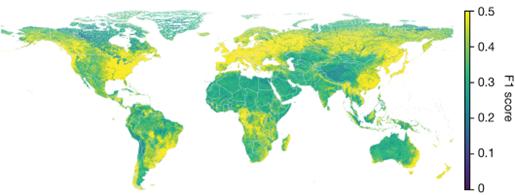Floods are one of the most common natural disasters, with a disproportionate impact in developing countries that often lack dense streamflow gauge networks1. Accurate and timely warnings are critical for mitigating flood risks2, but hydrological simulation models typically must be calibrated to long data records in each watershed. Here we show that artificial intelligence-based forecasting achieves reliability in predicting extreme riverine events in ungauged watersheds at up to a five-day lead time that is similar to or better than the reliability of nowcasts (zero-day lead time) from a current state-of-the-art global modelling system (the Copernicus Emergency Management Service Global Flood Awareness System).
In addition, we achieve accuracies over five-year return period events that are similar to or better than current accuracies over one-year return period events. This means that artificial intelligence can provide flood warnings earlier and over larger and more impactful events in ungauged basins. The model developed here was incorporated into an operational early warning system that produces publicly available (free and open) forecasts in real time in over 80 countries. This work highlights a need for increasing the availability of hydrological data to continue to improve global access to reliable flood warnings.

Floods, the most common natural disaster, have surged in frequency due to climate change-driven disruptions in the hydrological cycle. With nearly 1.8 billion people at risk—89% of whom live in developing nations—the need for effective forecasting is urgent. The World Bank estimates that improving early warning systems could save 23,000 lives annually. The new AI-based system, accessible via Google’s Flood Hub (https://g.co/floodhub), aims to meet this challenge by delivering forecasts without cost or registration barriers.
The study compares the AI model, which uses long short-term memory (LSTM) networks, to the current state-of-the-art Global Flood Awareness System (GloFAS). Trained on publicly available streamflow data from 5,680 gauges worldwide, the AI model outperforms GloFAS in predicting extreme flood events, achieving higher precision and recall for events with return periods of 1 to 10 years. Notably, the AI system extends reliable forecasts up to 5 days ahead, matching or surpassing GloFAS’s same-day predictions.
A key innovation is the model’s ability to forecast in ungauged basins—watersheds lacking stream gauges, which are prevalent in developing countries due to limited infrastructure. The study highlights a strong correlation between a nation’s GDP and its streamflow data availability, underscoring the inequity in forecasting capabilities. By using open datasets and machine learning, the AI model overcomes these limitations, offering scalable and reliable predictions even in data-scarce regions.
The system’s performance varies by region, with significant improvements in Africa, where forecast reliability now approaches European standards. However, challenges remain, particularly in South America, where both models show lower accuracy. The researchers emphasize that increasing global access to hydrological data could further enhance predictions.
The forecasts are disseminated in real time through open-access platforms, supporting timely warnings via smartphone alerts and the Common Alerting Protocol. The model and historical forecasts are available in open-source repositories, including the NeuralHydrology GitHub, encouraging collaboration and further development.
Lead researchers stress the importance of open data initiatives, such as the Caravan project, to refine flood prediction models. “Our work shows that AI can transform flood forecasting, but global cooperation in data sharing is critical to protect vulnerable communities,” said a study co-author.
This AI-driven system marks a significant step toward equitable, life-saving flood preparedness, offering hope to millions in flood-prone regions worldwide.
Sources:
Nature
https://www.nature.com/articles/s41586-024-07145-1 .
Provided by the IKCEST Disaster Risk Reduction Knowledge Service System
Comment list ( 0 )
